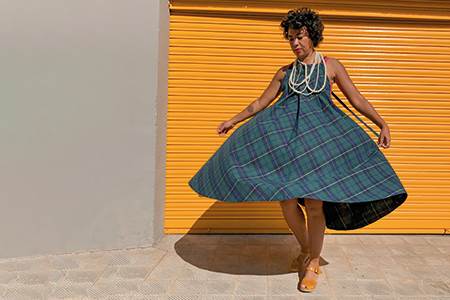Towonda Vaughns: Building the human connection

Two decades in denim design and development has taken Towonda Vaughns around the world, giving a long-lens perspective on how the industry is changing. She believes travel is key to appreciating the symbiotic role of brands and manufacturers, and has developed a new-found love for denim-inspired crafting, as well as supporting charities through fashion-based initiatives.
Q You have worked for both brands and garment factories, collaborating up and down the supply chain. What are some of the most important lessons you have learned?
A I don’t even know where to start here! Firstly, I would say perfecting the art of flexibility and that there is no one right way to get things done. This is especially true when dealing with so many entities on each project. When it comes to denim, we are in an ever-changing industry. I have been specialising in denim washing, product developing and design for over two decades so I have experienced the reckoning when it comes to figuring out more sustainable ways of washing. When I started in this industry, we were certainly doing amazingly creative things with washing but at the time had not realised the true environmental and human ramifications of this creativity paired with mass production. Now, with clear examples of the negative effects of the wet processes from many years ago, we have had to do a 180° and start producing in a responsible way.
What does it mean for me? Placing myself in “student mode” to investigate how to work on better ways to design and produce. I have had to learn how to ask the right questions when working with factories to make sure that what I am doing does not have a negative impact in any way.
One very important lesson that has always stuck with me is the importance of going to the places where you manufacture. This is not only imperative to promote transparency and to “get the job done” efficiently but to actually see who is making our product. To put a human and cultural face to the process. To connect on a human level. To see the people on the other side of the world as not just faceless bodies “working” for the companies or me personally but as necessary partners.
How does living and working in different countries shape your attitude or understanding of the fashion industry?
I have been lucky enough to travel to many countries on behalf of the brands in which I have worked. Coming from the US, and New York in particular, I had a very specific approach to design and my understanding of how I saw the industry. To be honest, I had great experiences but it was stressful, with emphasis placed on producing at high intensity with little regard to personal wellbeing.
Once I started to travel, I realised that my counterparts in each country had their way of approaching design and life in general. I have always known that I would end up living abroad and with that mindset, took the first leap in 2010 to live in Shanghai for six years. It was there that I started to understand the other side of the fashion chain, the side that a lot of designers don’t get to see deeply due to company budget constraints, etc… the realities of production, the reasons why we can or cannot construct garments in a certain way. I was able to now get a 360° view of the industry.
Once I made the decision to move to Europe, my mind was again blown away with how people in the industry lived their lives. It was when I moved to Germany that I realised the importance of work/life balance — that you can do a great job and put your heart into it while taking time away to enjoy life with loved ones. The fashion industry was no longer this big machine that was draining my spirit. I started to fall in love again with my craft because of the ability to step away at times to enjoy life and place importance on balance again. I went from a world that didn’t allow much time for reflection, where it was a positive thing to see someone work ‘til midnight as a sign of dedication, to a world that pushed for dedication but in a more holistic way. Working 15-hour days was a sign that something was wrong with time management. I also appreciated working out of different countries and witnessing the intersection between the industry and the respective cultures and customs.
What are some of the key wet processing developments that you’ve seen over the years that have made the most difference? Any recent innovations that you’re keen on?
When people complain about this industry, especially us designers who don’t feel that we are as creative as we would like, working in corporate fashion for many reasons, I have to remind myself that I am actually fortunate to be a part of the denim world. We are a special tribe within an industry and I feel lucky to be a part of this community because we actually get to be creative and the creativity comes in the form of working on new, innovative and sustainable wash and dyeing techniques.
Over the years, we have had to evolve at rapid pace and prove that we are not a group of people that doesn’t care about the environment, the health of others and ourselves, so it is constant problem-solving and finding better solutions.
The most important for me is the influx of modern machinery that any factory that wants to be a part of the solution has invested in. Water wastage or contaminated water has been a major issue in our industry so I am happy to see the machinery that wash or dye garments with minimal water wastage such as the machines from Jeanologia, Tonello and Yilmak, for example. I am also noticing more and more factories are investing in effluent treatment plants (ETP) to purify industrial wastewater for reuse. Also, the introduction of alternatives to potassium permanganate, pumice stone-free washing, industrial bleach alternatives. On the fabric side, the ability to produce PIW (post-industrial waste) or PCW (post-consumer waste) recycled cotton through the shredding and breaking down of unused product into a new fibre to be re-spun and made into fabric via the Laroche machine. Of course, from many years ago, the discontinuation of sandblasting. However, there are still many companies utilising this process despite the clear connection between sandblasting and silicosis.
How do you balance supply chain investments in terms of sustainability with keeping costs acceptable for brands? Who do you think should pay for “sustainability”?
This is a tough question because as much as we all want to produce, and buy sustainably, the reality always comes down to cost and what a company is willing to spend for it. All of the innovations that I mentioned earlier tend to come with extra costs due to many reasons such as production time, if it is new to market, maybe the demand isn’t yet high enough, adjustments to formulae, to name a few.
For the suppliers, part of their function is to come up with innovative and sustainable options to get the units from the brands, especially those that garner high unit orders. I have been in numerous meetings in which we were all excited about a new technology to make the product more sustainable, only to fall back on the conventional way due to cost. The question for brands has become, how can we utilise this while maintaining our margins and not increase the retail? I can easily say that the retail prices should also increase and if the consumer is educated about the reasons for the increase, they will accept.
However, what about the consumers who do not have disposable income and can barely afford to get by? Are we to expect them to jump on this “sustainability train” and pay more for product? I think we all have to play a role in pushing for sustainability whether it’s the supplier who is producing to lower their cost in a realistic way in respect to their overhead, the brands (especially the mega ones) can adjust the margins a bit to accommodate. Depending on the tier, the consumer can share a bit on the cost as long as the quality and longevity is there (with explanation!), and maybe for extreme bargain companies, if they can’t raise the prices because of their customers’ financial limitations, offer fewer styles and put the numbers behind a smaller assortment for better price negotiations.
I am still sorting out my opinions on this topic because I am willing to pay more for quality and sustainability, half of my own wardrobe and accessories are well over 20 years old, proudly, and it is because I paid for quality over trendy. I was only able to do this because I just happen to be in a career that warranted me a decent pay cheque though. It is not fair to push this ethos onto everyone and be judgmental about it, thus bringing me to another point… how do we prevent the “sustainability” from becoming interchangeable with exclusivity? Or “gate keeping”?
Where is the market heading in terms of trends? Has Y2K got staying power?
I can’t believe that I am reliving this trend already. The good thing about trends lately is that they don’t seem to change over so quickly now. This is bringing me to the point that it is no longer necessary to put out whole new completely different collections every month. It is wasteful. With that said, I do see it sticking around for a bit but then evolving via colour, fabrications but maintaining the comfort, well, at least for the bottoms. It’s been many years now that we have been embracing more comfortable silhouettes that allows for flexibility in activities; day attire into night-out-in-the-city attire. I have seen this trend in both settings and that usually tells me that a trend will stick around.
Maybe it is where I am living these days or just the sign of the times but I am feeling that more and more people, regardless of age group, are less interested in jumping on of-the-moment trends and more on experiences. Comfort has definitely taken more of a prominent role but you can do comfort in a sexy way as well. I am seeing more and more people becoming interested in making things last via upcycling – learning how to make your own alterations, transforming older garments into something cooler. I see so many videos out there now of young people transforming their clothes and I am here for it!
What changes would you like to see?
I would love to see people become more and more self-sufficient in their daily lives. I want to see more and more companies take responsibility for providing sustainable and durable options while being transparent about their supplier partners, as it is the right thing to do. I want to see factories protect their technicians physically and monetarily. Yes, I already see major improvements in this area but let us not forget the factories that are operating on the fringes by selling dirt-cheap product to companies who want to pay the bare minimum… we would be naive to think that all of the rules are being followed in that regard.
I want us as individuals to do our part by shopping less and fixing things that are broken instead of throwing away and buying new product unnecessarily. This is not just with apparel; it is with everything. If you have old fabric or clothes around, figure out a way to transform them into something for homeware, for example.
I would like to see more of a human connection between the people working for the brands and the people working for the factories so that we can understand that we are all important in this supply chain. This was brought to light during the pandemic when factories called out the perils of not being paid for product already produced. The great thing is that I am very much optimistic about these things.
Aside from work, what are you passionate about and what makes you happy?
Geez, way too many things! I am lucky to be able to include my work in denim as a passion because of the constant learning involved. My new passion is working with ceramics! I have discovered a whole new infinite world in this craft where the possibilities seem to be endless. I am now trying to explore ways to combine the two worlds and focus on practical solutions.
My passion involves anything to become self-sufficient. I make my clothes when I can, I am crazy about upcycling textiles and scraps into home textiles. My goal is to make as much as possible and even includes getting into horticulture. I want to figure out ways to produce less waste as an individual and reuse, reuse, reuse!
The one thing that really gives me purpose above all of these things is applying what I have learned over the years to helping others in my community. I signed on with an amazing woman in Barcelona named Laura Avery and together we formed a collective called Fashion Cares in which we organise events to promote pre-loved shopping with the backdrop of music, entertainment and fashion catwalks, spotlighting local artisans, amongst others, with 100% of proceeds going to local charities. This is what is truly making me happy because I get to see proof that people generally do care about each other and will help us to help others.
Describe a great day.
Usually a Saturday because I am dancing! All day long!
US born Towonda Vaughns has worked as a denim designer, wash specialist and product development manager for brands including Tommy Hilfiger, Nautica Jeans, Esprit and DKNY Jeans, leading teams to produce garments in the most sustainable way. As part of her work, she has lived in China and Germany and was also global design director at Artistic Fabric Mills, Pakistan. She is now creative director of her own consultancy firm and lives in Barcelona, Spain.
Photos: Towonda Vaughns. Gydeonvaldezdoesshanghai













